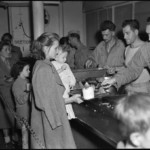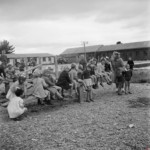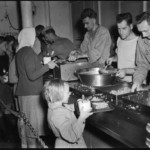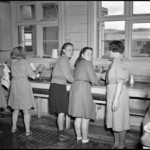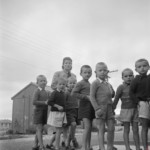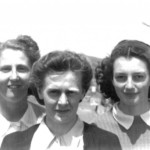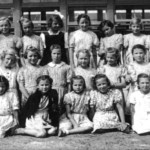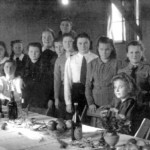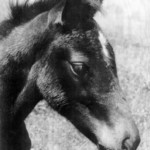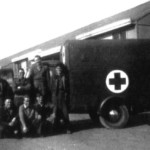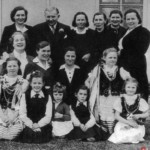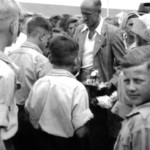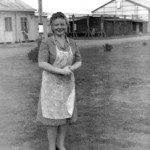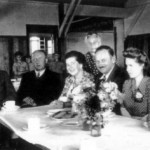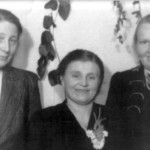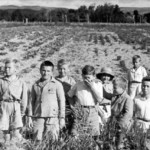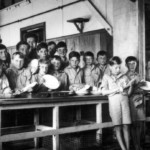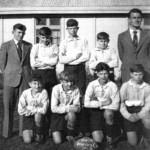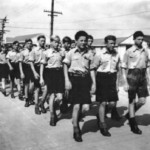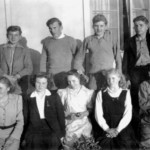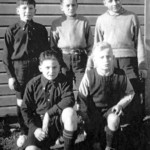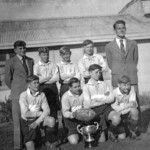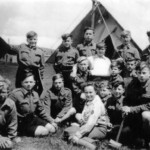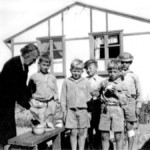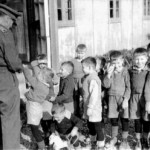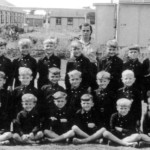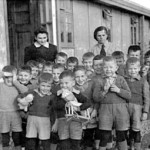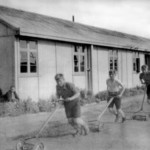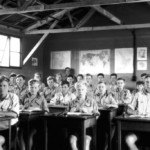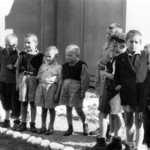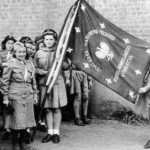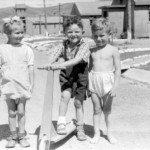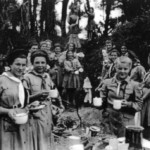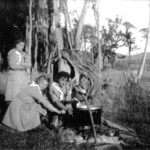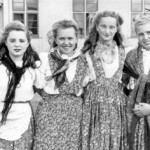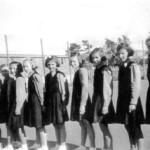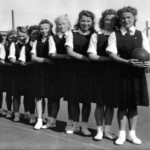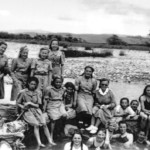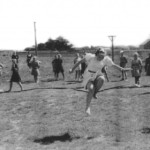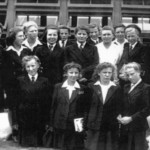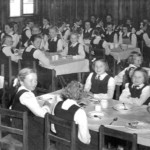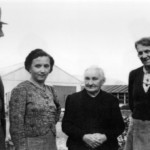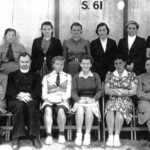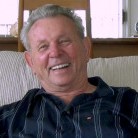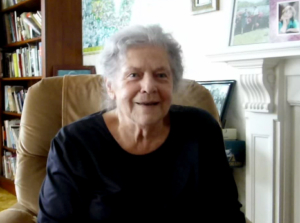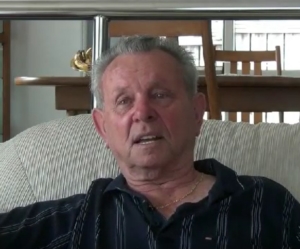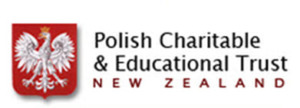Polish Refugees in New Zealand 1944-1951
Exhibitions
Daily Life
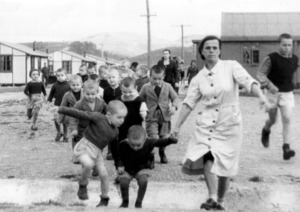
The youngest children in Pahiatua camp on their way to the dining room with Stanisława Lewandowska, who was dedicated to looking after them on their journey to New Zealand and at the camp. She was affectionately called the ‘white mother’ because she always wore a white coat and was a like a mother to the youngest children. Source: Polish Children’s Reunion Committee 2004.
Dr Andrzej Chibowski: Each day at the camp was filled with varied activity according to a plan. The camp siren woke everyone at seven in the morning. This was followed by dressing, a wash, communal prayer and making the beds. They went to breakfast in orderly groups. Classes started usually at 9 o’clock. There was a hot meal at midday. Classes finished at 3 o’clock, after which the rest of the afternoon was their own. They played communal games such as soccer, netball and other specifically Polish games, go roving about or read. Permission had to be requested to leave the camp’s environs but “sneaking out” to the surrounding fields, or exploring the native bush or river was not uncommon. But all children were back on time before the siren announced the evening meal or to their allocated duties. The day ended with a roll call in each dormitory, with the day’s announcements, common prayers and lights out at 9 o’clock. Saturday was devoted to general cleaning, beating out blankets in the open air, polishing or oiling of the wooden floors and mowing lawns.
Immediately after the arrival at the Pahiatua camp, teaching was extended to all children able to attend school. There was also pastoral care and the Scouts movement. These three institutions, school, church and Scouting, developed the children’s character, minds, hearts and patriotic attitudes. Teachers were keen to begin school education as soon as possible. Because of the children’s age range (the youngest were under two and the oldest 19, education had to be multilayered. A preschool, primary school and secondary school functioned from the beginning. On the first day after arrival the camp, commandant Jan Śledziński called up the teaching staff which had already been appointed in Iran. Halina Zięciak took up the post of school director, Krystyna Skwarko became the head of the boys’ school, Jadwiga Żerebecka of the girls’ school and Jadwiga Tietze of the preschool.
Fr Michał took the post of teacher of religion in the secondary schools and older classes of the primary school. He was assisted in this by Sister Monika Alexandrowicz and Wanda Pietrasińka. One of the children, Stanisław Manterys, recalls:
“Fr Michał Wilniewczyc was a much-liked priest. We called him by the diminutive version of his first name, Michaś (pronounced Meehush), but addressed him as “Father” out of respect. Soon after arrival at the camp, classes, which had been suspended for the duration of the journey from Iran, resumed in the newly erected prefabricated school buildings. Religion classes were one hour per day. Fr Michaś came to our class before midday and taught us the catechism and read interesting stories from the Old Testament Bible. Winter days in Pahiatua can be very cold, when the central heating could not cope. On such frosty mornings Fr Michaś took us to his residence in the small hut into which he managed to squeeze in 30 boys. He then prepared hot milk on the small iron stove and served it up with cocoa in army tin cups. We had to take turns because he only had a few cups, the boys impatiently waiting for their turn, while the class was in progress. Not certain of our future, he was also keen to improve our knowledge in matters other than religion, such as astronomy, history and nature.”
He also taught Latin in the two higher classes. An important element in the camp life was a religious upbringing. One of the boys, Antoni Leparowski, recalls:
“The sole priest at the camp, Fr Wilniewczyc celebrated daily Mass in the chapel, followed by the beautiful evening devotions. Each Sunday at 10 o’clock Mass was celebrated in the main hall for the whole camp.”
Stanisław Manterys recalls:
“A specially designed tall wardrobe on wheels stood in the corner of the stage. It was wheeled to the centre of the stage before Sunday Mass. When opened, the wardrobe revealed a ready altar. Vespers and other religious services were also held there when the chapel next door was too small to hold all the faithful. After the services the wardrobe was shut and the place returned to its function as a public hall.
Regular weekly films were shown on a suspended screen. Cowboy films were very popular with the boys, which they eagerly awaited. Though the local bishop had given his approval, Fr Michał was not happy that films and shows were held in the same place where Mass was celebrated.
A Priest’s Odyssey; p95-97
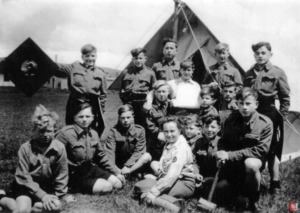
Polish Scouts at the Camp with chief scout Stefania Kozera. Standing (l-r): Stanisław Wołk, Kazimierz Wiśniewski, Tadeusz Zioło, Julian Borowiec, Kazimierz Walczak Sitting (l-r): Alfred Sapiński, Mieczysław Ptak, Bronisław Rożniatowski, Jerzy Jankiewicz, Stefania Kozera, Czesław Pelc (arm in sling), Lech Lubas, Jan Lasota, Jan Kowalski, Adam Banaś, Krzysztof Jasiński (Staszczuk). Source: Polish Children’s Reunion Committee 2004.
Polish Children’s Reunion Committee 2004: Shortly after Lord Baden-Powell founded the Scouting movement for boys, it was wholeheartedly embraced by the Polish people in 1911. No distinction was made and both sexes were called Scouts.
Poland at this time was partitioned (until 1918) and the new Scouting movement encouraged patriotism, allowing the Poles to express themselves, as well as being a youth organisation that was fun and character building. Therefore it is not surprising that as soon as the Polish children arrived in Iran after fleeing the forced-labour camps in the USSR, Scout companies were formed even before schools were established. When they arrived in the Polish Children’s Camp in Pahiatua, three-quarters of the children were in established Girl Guide and Boy Scout troops, Brownies and Cubs under the great leadership of Scout troop leader Stefania Kozera and the older girls and boys who helped her.
In the camp, Scouting was a big part of the children’s lives. At first it filled a void because of the lack of extracurricular facilities and equipment (there were no musical instruments in the camp’s early days and only one radio). But even after the sports teams were organised and the camp became more established, Scouting was a mainstay. It was a great leveller and a main form of entertainment.
At school it was often only the extra bright children that were particularly noticed. But in Scouting almost all could excel at something. Whether an individual had a particular talent for fire lighting, an especially beautiful singing voice, leadership qualities or the ability to teach others a skill, all of them had the opportunity to shine and develop very close bonds with the other children.
There were many Scout campfires. The first one was dedicated to all Scouts and people who had lost their lives in the unsuccessful Warsaw uprising, so it was a very moving occasion. Those gatherings around the campfire mirrored the children’s emotions. To ease their terrible bouts of homesickness, they organised “excursions around Poland”, with lots of singing, poetry and regional dancing, and celebrated Polish national days, religious days of importance and various anniversaries. For example, the anniversary of the Polish army’s victory at Monte Cassino was a joyous evening which filled them with great pride.
It didn’t take the Polish children long to befriend New Zealand Scouts and Girl Guides. Many New Zealand children had lined the tracks and greeted them as they travelled by train from Wellington to Pahiatua, while others had welcomed them at Palmerston North Railway Station. Girl Guides from Pahiatua had also helped prepare the camp for their arrival.
The friendships, ignited on the first day in New Zealand, continued to grow. Troops met on many occasions to participate in various “drives” and activities, the most important being the blessing of the Polish Scout flag. Guides and Scouts came from Pahiatua to the camp for the day. Kiwis and Poles took part in activities, shared meals, joined ranks to march in parade past New Zealand and Polish Scout and Guide officials, and bowed their heads together for the blessing of the flag. On another occasion a group of older Polish Girl Guides went to a Girl Guide leadership training camp in Waipawa.
New Zealand First Refugees: Pahiatua’s Polish Children, p332-333
Voices
Photos
